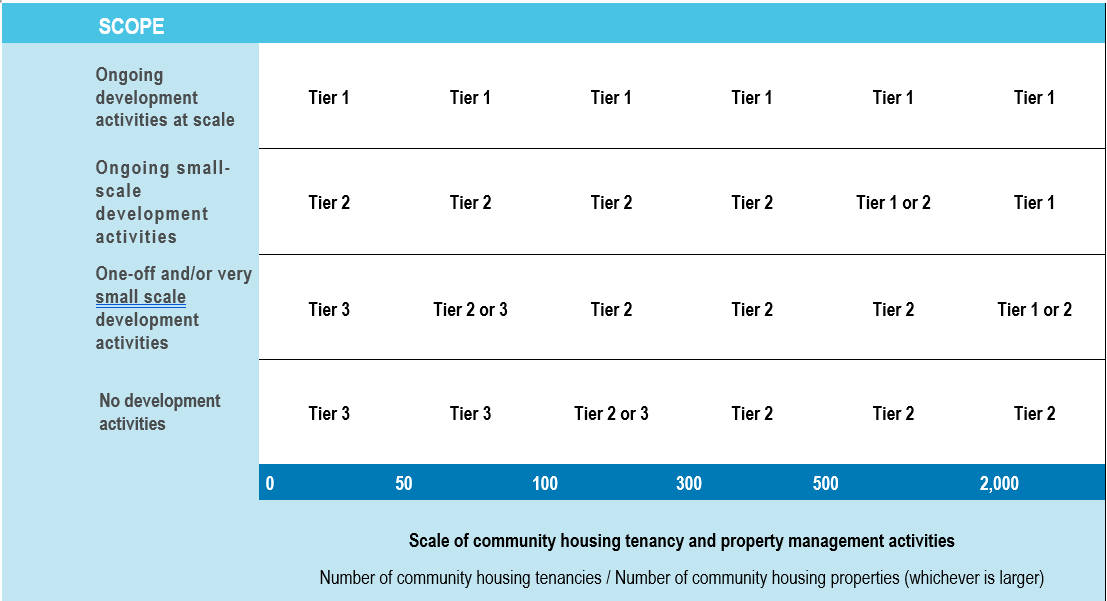The registration category, referred to as tier, is determined by an organisation’s level of risk due to the scale and scope of its activities. This is the first level of risk stratification to support a risk-based approach to regulating community housing providers. The tier of registration determines the performance requirements and intensity of regulatory engagement.
Assessing performance data is the second level of risk stratification, which deals with the nature and intensity of regulatory engagement and, where necessary, action.
Community housing providers are registered under the National Regulatory System for Community Housing in one of three categories of registration referred to as Tier 1, Tier 2 and Tier 3.
To be registered in a particular tier, an entity must:
Information to assist community housing providers to determine when, how and what affiliated entity arrangements should be disclosed is located on the Affiliated Entity Arrangements page.
An entity or a registered community housing provider may apply to be registered in any tier. The onus is on the applicant to show that it meets the requirements. This applies to applications for registration and ongoing compliance assessments.
A Registrar may only place an entity in registration Tier 1 if the entity:
Tier 1 providers face the highest level of performance requirements and regulatory engagement – reflecting the fact that Tier 1 providers are involved in activities that mean they manage a higher level of risk based on:
A Registrar may only place a community housing provider in registration Tier 2 if the entity:
Tier 2 providers face an intermediate level of performance requirements and regulatory engagement – reflecting the fact that Tier 2 providers are involved in activities that mean they manage a level of risk that is lower than Tier 1 providers but higher than Tier 3 providers based on:
A Registrar may only place a community housing provider in registration Tier 3 if the entity:
Tier 3 providers face a lower level of performance requirements and engagement – reflecting the fact that Tier 3 providers are involved in activities that means they manage a lower level of risk based on:
A Registrar’s determination about the category of registration under section 14 (2) (c) of the National Law will be based on evidence provided by the entity:
In determining the registration tier under section 13 of the National Law, the Registrar will consider:
The description of registration tiers refers to attributes of community housing activities such as operating at scale, involvement in development activities and finance and leverage arrangements.
The following interprets these terms in the context of registration tiers. Importantly, the definitions are framed in qualitative terms to reflect that there is not a single ‘black box’ formula for registration tiers and an element of judgement is required to assess the risk associated with a provider’s community housing activities.
The scale of community housing tenancy and property management activities is typically classified as:
The definitions are deliberately presented as a range to highlight that provider ‘scale’ is always considered relative to other attributes such as development activities and finance arrangements. In addition, it is recognised that a new entrant may initially have a zero base but a specific plan to operate at a certain scale.
Community housing development activities refer to property development involving the construction or major refurbishment of community housing assets. Development activities are classified as:
Development scale is set relative to the national market, the size of which will be influenced by a range of factors, notably the economic outlook and funding opportunities. The assessment of development activity by registrars will take into account the number of units involved, the costs, financing arrangements and complexity of the development(s) in their tier assessment.
Registrars will also take into account whether a provider’s development programme is ‘ongoing’. This refers to the existence of a committed forward program. It does not necessarily require that particular schemes are ‘shovel ready’ but that for example:
Finally, in coming to a decision about an appropriate tier, Registrars will also consider the scope of a provider’s affiliated entity arrangements. Providers engaged in complex relationships and interdependencies with parent or subsidiary entities; contractual partnerships or some form of cross-guarantee may be determined to be in a different tier to another with the same number of tenancies, assets and development.
Risk is not static and may change over time; this in turn may lead to a change in the registration tier. A change to the registration tier of a registered community housing provider may be initiated by either:
When making a determination to change the registration tier of an entity under section 12 (4) of the National Law, the Registrar will:
A Registrar’s decision to change a provider’s registration tier or to refuse a provider’s application to change its registration tier is an appealable decision under section 25 (1) (a) and (d) of the National Law.
To assist community housing providers to understand the likely registration tier under which they would need to seek registration, a matrix has been prepared to provide examples of registration tiers. In practice, a provider may choose to seek registration in a higher tier (if the provider can demonstrate that the provider meets the requirements) or a Registrar may require registration in a higher tier (if the Registrar assesses there is a higher level of regulatory oversight required).
For example, a Registrar may reject an application for Tier 3 registration if the Registrar makes a determination that Tier 1 or Tier 2 regulatory oversight is required based on the entity’s community housing activities. A Registrar may reject an application for Tier 2 registration if the Registrar makes a determination that Tier 1 regulatory oversight is required based on the entity’s community housing activities.
Select the scope of different community housing activities below to view the registration tiers.

To view the accessible version of the above table, please see Example of the typical registration tier for different community housing activities.
Last updated: